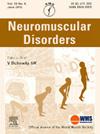211P 跟踪病人在日常生活中的行动能力:EJP-DT4RD 项目
IF 2.7
4区 医学
Q2 CLINICAL NEUROLOGY
引用次数: 0
摘要
DT4RD(Digital Tools 4 Rare Diseases,罕见疾病数字工具)项目致力于开发一种非侵入性工具箱,用于测量患者在日常生活中的活动能力。尽管过去几年在这方面取得了巨大进步,但仍亟需获得与疾病相关的信息,从而产生监管机构认可的基本临床和患者相关结果。这些数据可以通过数字化手段,利用可穿戴设备、传感器、视频和智能手机应用程序等工具加以利用。例如,病人家中、身上佩戴的运动传感器或移动辅助设备可以评估一般运动,同时区分病人的自主和非自主运动。新型临床结果评估(COA)的开发有可能促进罕见病的药物开发过程,并有助于提高患者护理的生活质量、临床结果和在家庭环境中收集信息的能力。对患者行动的远程评估还能降低间接成本,如前往研究地点的差旅费和误工费,从而提高患者研究的可及性。本研究的目的是比较医院用 COAs 和家庭用 COAs,以验证它们在远程监测患者方面的应用。招募对象为 40 名确诊患有神经肌肉疾病的患者。我们将对参与者进行为期一年的随访,包括三次医院探访和在家中的定期记录。我们将介绍对 12 名患者进行 6 个月随访的初步结果。该项目使我们有可能对获取患者信息的传统方法提出质疑,并为在日常生活中获取以患者为中心的真实数据创造了新的机会。家庭监测为临床试验中的行动能力评估提供了一种科学先进的方法。通过对行动能力参数进行客观、连续和真实的监测,它提高了数据质量、生态有效性和患者参与度。在临床试验设计中整合家庭监测技术可以彻底改变行动能力评估结果,从而更准确、更有意义地了解患者的行动能力、变化以及对干预措施的反应。DT4RD 计划由欧洲罕见病联合计划提供资助,并由 Chiesi 和 CSL Behring 共同出资。本文章由计算机程序翻译,如有差异,请以英文原文为准。
211P Following patient mobility in daily life: the EJP-DT4RD project
The DT4RD (Digital Tools 4 Rare Diseases) project is dedicated to the development of a non-invasive toolbox that measures patient mobility in daily life. Although tremendous progress has been made in this regard in the last few years, there is still a strong need to obtain disease-related information that generates fundamental clinical and patient-relevant outcomes accepted by regulators. Such data can be harnessed through digitised means using tools such as wearable devices, sensors, videos and smartphone apps. For example, movement sensors in the patient's home, worn on the body, or mobility aid can assess general movements whilst distinguishing between the patient's voluntary and involuntary actions. The development of novel clinical outcome assessments (COA) has the potential to facilitate the drug development process across rare diseases and support the improvement of the quality of life for patient care, clinical outcomes and ability to collect information in the home environment. The remote evaluation of patient movements can also reduce indirect costs, such as travel to study sites and lost wages, thereby increasing the accessibility of research studies for patients. The aim of this study is to compare hospital-based COAs with home-based COAs to validate their use for remote monitoring of patients. The recruitment target is 40 patients with confirmed diagnosis of a neuromuscular condition. Participants will be followed for one year with three hospital visits and regular recordings at home. We will present preliminary results obtained from 12 patients followed for six months. This project gives the possibility to question the classical ways of obtaining information from patients and creates new opportunities for acquiring patient-centred real data in daily life. Home monitoring provides a scientifically advanced approach to mobility assessment in clinical trials. By offering objective, continuous, and real-world monitoring of mobility parameters, it enhances data quality, ecological validity, and patient engagement. The integration of home monitoring technologies in clinical trial designs can revolutionise the assessment of mobility outcomes, leading to more accurate and meaningful insights into patients' mobility abilities, changes, and responses to interventions. The DT4RD program is funded by a grant from the European Joint Programme on Rare Diseases and co-funded by Chiesi and CSL Behring.
求助全文
通过发布文献求助,成功后即可免费获取论文全文。
去求助
来源期刊

Neuromuscular Disorders
医学-临床神经学
CiteScore
4.60
自引率
3.60%
发文量
543
审稿时长
53 days
期刊介绍:
This international, multidisciplinary journal covers all aspects of neuromuscular disorders in childhood and adult life (including the muscular dystrophies, spinal muscular atrophies, hereditary neuropathies, congenital myopathies, myasthenias, myotonic syndromes, metabolic myopathies and inflammatory myopathies).
The Editors welcome original articles from all areas of the field:
• Clinical aspects, such as new clinical entities, case studies of interest, treatment, management and rehabilitation (including biomechanics, orthotic design and surgery).
• Basic scientific studies of relevance to the clinical syndromes, including advances in the fields of molecular biology and genetics.
• Studies of animal models relevant to the human diseases.
The journal is aimed at a wide range of clinicians, pathologists, associated paramedical professionals and clinical and basic scientists with an interest in the study of neuromuscular disorders.
 求助内容:
求助内容: 应助结果提醒方式:
应助结果提醒方式:


